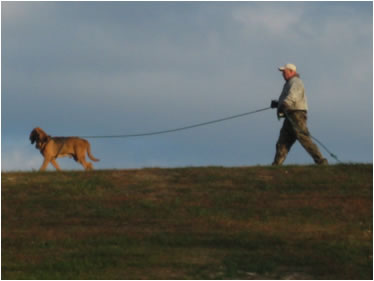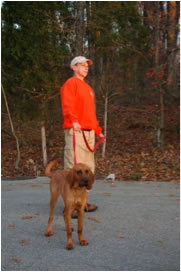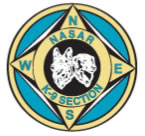| Search
Dog Training
OVSAR uses all
working breeds of dogs, such as Border Collies, German Shepherds, Labradors,
and Golden Retrievers. We like to begin training a dog as young as 12 weeks
of age, but older dogs are also considered. Wilderness search dogs must
be trained and certified in one of three methods: tracking,
trailing
,air scent or cadaver.
Dogs first taught
to track or trail may later be trained in air scent. However, dogs first
taught to air scent can rarely be taught to track or trail because air
scenting is the easiest and most natural for the dog. Often air scent dogs
naturally combine all three methods to locate a subject.
Dogs instinctively use their noses to locate things in everyday life, so
the real training is to teach them (1) to locate the lost person or article
and (2) to notify the handler that the subject or article has been found.
This notification is called the alert.
Dogs can locate
people because all humans have an individual human
scent left behind by the 40,000 skin cells dropped per minute. Air
currents carry these cells that dogs can detect with their sensitive nose.
Search Dog
Training - General
Training search
and rescue dogs is a gradual and careful process because each dog responds
differently. All dogs progress at different rates and their reactions to
training challenges and rewards will also vary. OVSAR regards training
as a team effort. We use a variety of subjects for mock search exercises
and we rely on each other for support and advice. OVSAR uses the training
methods described in this section but is not restricted to these only.
PLEASE
keep in mind this is a VERY brief explanation of our training methods.
It is not
a comprehensive training guide - it is only an overview.
TRACKING
SEARCH DOG
Phase I
The tracking
dog is worked in a harness attached to a 20 - 30 foot lead. The handler
puts the harness on the dog just as the team (handler and dog) get ready
to work. This way the dog associates the harness with the tracking and
is more focused to start working. To start training a tracking dog, we
begin by having a familiar subject drop a scent
article and make a scent pad, then
walk 10-20 feet, laying food treats in each step. The subject then hides
in an easily detected  location. The handler shows the scent pad and scent
article to the dog, then the handler gives a command such as "find" or
"search." The dog follows the scent and the treats to the subject and is
given enthusiastic praise and a reward such as more treats or a favorite
toy. We continue these short searches using fewer treats each time. We
also use different terrain's, such as fields, yards, parks, lightly wooded
areas, etc., but with no heavy vegetation or concrete surfaces in this
phase. location. The handler shows the scent pad and scent
article to the dog, then the handler gives a command such as "find" or
"search." The dog follows the scent and the treats to the subject and is
given enthusiastic praise and a reward such as more treats or a favorite
toy. We continue these short searches using fewer treats each time. We
also use different terrain's, such as fields, yards, parks, lightly wooded
areas, etc., but with no heavy vegetation or concrete surfaces in this
phase.
Phase II
We continue
using the scent article, scent pad and a few treats (every 5-10 steps),
but we increase the length of the search. These short searches should always
be in a straight line. When the dog starts getting the idea of the search,
keep him from seeing the victim hide. We add more variety to the locations
used, and even use some with heavy vegetation.
Phase III
In this phase
we add curves and eventually stop the track treats. As the dog's ability
increases, we start adding distance and age to the track and continue exposing
the dog to a wide variety of terrain's. The use of the scent article is
always needed but the scent pad must be phased out as the dog becomes more
accomplished.
Phase IV
When the dog
is reliably finding the victim through these phases with no treats and
a trail of ten minutes or more, we next use a subject unknown to the dog.
We add variables to the searches as the dog is able to successfully complete
each level.
Phase V
Two people are
now used: one as the victim and one as a distraction. The subject leaves
the scent article and both the subject and the distraction walk away together.
At a predetermined distance the distraction breaks off and leaves the search
area while the victim continues on. The tracking dog must stay on the subject's
track and locate the subject, even though the distraction turned in another
direction.
The tracking
dog team (handler & dog) should be able to consistently work trails
up to 24 hours old that are 1-2 miles long in all terrain's. This
phase is basically for the tracking dog that is ready for the tracking
certification test.
PLEASE
keep in mind this is a VERY brief explanation of our training methods.
It is not
a comprehensive training guide - it is only an overview.

TRAILING
DOG
A trailing dog
works similarly to the tracking dog. A scent article is used so the dog
can pick up the subject's scent and trail. The dog may waiver from the
person's actual track by several feet by cutting corners and using the
wind to his advantage. Again, the dog is generally in a harness attached
to a 20 -30 foot lead.
PLEASE
keep in mind this is a VERY brief explanation of our training methods.
It is not
a comprehensive training guide - it is only an overview.
AIR
SCENT SEARCH DOG
The air
scent dog works off lead, ranging back and forth in an area to pick
up the human scent left by the subject.
Ranging often takes the dog out of sight for several minutes at a time,
so the handler must trust his dog and listen for an alert.
Once the dog gets the subject's scent, he moves in to its source. The dog
must then "alert" by either barking while staying with the subject or by
returning to the handler and "indicating" her in some way that the handler
should follow. The dog then "refinds" the
subject and leads the handler to the subject.
To train an air
scent dog to issue a bark alert, we
start training the dog to bark on command as young and as soon as possible.The
bark alert is usually the hardest area of the search sequence to get the
dog to do reliably, so we start early on this behavior.
New handlers
usually want to progress quickly through the phases, but we have found
that if the foundational steps are not solid and reliable, the whole process
will eventually fall apart. We stress a very slow, steady training sequence
for the new dog to assure a solid foundation.
Phase I
Team
members start with runaway searches for the new dog. A person the dog is
familiar with holds the dog while the handler excites the dog and then
runs away (into the wind) and hides. All this is done in full view of the
dog with the reward, preferably a toy, in the runaway subject's hand. The
handler then gives a command such as "search" or "go find" and releases
the dog. When the dog reaches the handler it is "party time" with lots
of playing and praise for the successful search. A search, no matter how
short or long, is a big game to the dog, so it is always "party time" when
the dog finds the subject. We continue with the runaway searches increasing
either distance or adding terrain variations. In general, we keep the searches
in a straight line and always into the wind during this phase.
Phase II
For
those dogs that we want to give a bark alert, we now add the requirement
that the dog barks when he reaches the subject. Usually the subject has
to give the "speak" command. Once the dog barks the handler comes in and
helps reward the dog with play and praise.
For dogs that
alert with a refind, the training varies. Once the dog reaches the
subject, the handler calls the dog back to her and gives a new command
to tell the dog to return to the subject, such as "show me" or "refind."
In the beginning of this training, the subject will most likely have to
call the dog back, then the handler and subject reward the dog enthusiastically.
We continue with short, straight searches but add variations in terrain,
location and subjects. Begin using people familiar to the dog as subjects
with the handler working the dog.
Phase III
Now the dog
is ready for "blind searches" where the subject hides without the dog watching.
It is essential to work into the wind so that the dog has the best chance
to catch the human scent. As the dog becomes more accomplished at this,
we make the searches longer and vary the terrain. If the dog fails to bark
or do a refind, we return to Phase II because we do not have the solid
foundation needed to continue.
Phase IV
Next we use
subjects unfamiliar to the dog and add variables such as length (distance
and time) and new terrain. We also begin starting the search in another
place than where the subject started from.
Phase V
Again, as with
the final phase for the Tracking Dog, Phase V is for the search team (handler
and dog) that is ready for the wilderness certification test. The team
needs to be ready to search for long periods with short rest breaks, covering
a wide variety of terrain in all kinds of weather. In spite of all the
work, we ensure that the dog finds searching fun by doing a variety of
searches, from short, fun runaways to the 1 - 3 hour search. Wonderful
rewards and praise always follow each successful exercise.
OBEDIENCE
TRAINING
During search
training we run through obedience exercises during search training, but
the actual obedience training is the individual handler's responsibility.
We recommend a formal obedience class for socialization, basic commands,
and experience.
Following dog
obedience training, OVSAR dogs must pass an extensive obedience test in
order  to represent OVSAR at various functions, such as fire department
open houses, parades, and school demonstrations. To progress to mission-ready
status, the dog must pass a test for search certification in one of the
three specific search disciplines. The standards for this test are similar
to the standards established by the National Association of Search and
Rescue (NASAR) and the State of Indiana. to represent OVSAR at various functions, such as fire department
open houses, parades, and school demonstrations. To progress to mission-ready
status, the dog must pass a test for search certification in one of the
three specific search disciplines. The standards for this test are similar
to the standards established by the National Association of Search and
Rescue (NASAR) and the State of Indiana. |

![]()

![]()

![]()

![]()